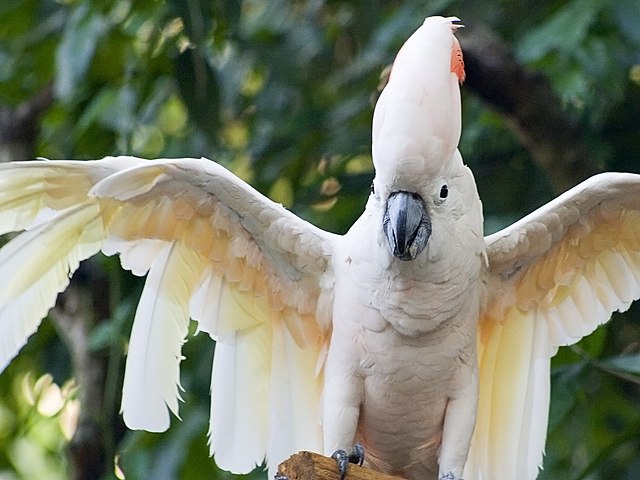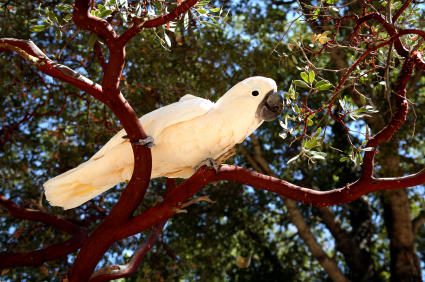Cacatua moluccensis, the Moluccan Cockatoo, is one of 21 species of bird in the Cacatuidae family. Moluccan Cockatoos, also known as the Salmon-Crested Cockatoo, are native to south Moluccas in eastern Indonesia. Their habitat is primarily lowland forests up to 3,300 feet.
The beautiful and flashy Moluccan cockatoo is the largest of the cockatoo species. They are generally thought of as white birds, though there is a distinctive salmon-colored cast to their overall appearance. Their recumbent crest displays a vivid salmon color when erect and the underside of their wing and tail are both yellow and salmon.

The highest population densities occur in primary forests, however, the species is also found at lower densities in secondary forests. It is the largest of the white cockatoos and unlike many species; the female is generally larger than the males. It has white-pink feathers with a definite peachy tint, a slight yellow on the under-wing, and an underside of the tail feathers.
Along with the Psittacidae family, also known as the True Parrots and the ones you’re likely to imagine when someone says the word “parrot,” Cockatoos make up the order Psittaciformes. Moluccans reach 18-22 inches in length at maturity. They are on the CITES endangered species list due to deforestation and the pet trade.
Moluccan Cockatoos, like other cockatoos and parrots, have a curved beak shape and a zygodactyl foot, a foot that has two forward toes and two backward toes. However, you can always tell a cockatoo by its crest, a collection of feathers on its head that it can raise or lower.
Moluccan cockatoos can be great pets. If you are considering the Moluccan Cockatoo as a pet you should read what we suggest as far as Cockatoo training so they do not bite or scream uncontrollably.
Unlike parrots, they also have a gall bladder. Their coloring, predominately white, is caused by the lack of the Dyck texture feather, a unique feather composition specific to parrots that enables them to have vibrant blue and green feathers.
Moluccan Cockatoos live forty or more years in captivity and reach sexual maturity around two to three years of age. When breeding, they generally lay one to four white eggs every two to three days.
The young hatch in 28 days and become independent in 12 to 14 weeks. Surgical sexing is recommended to determine gender since eye color is not always an accurate way to determine sex.
Moluccan Cockatoos are known for their cuddliness and affectionate disposition. They’re also known to be very demanding of their owner’s time. This demand for attention can result in a difficult bird with many behavior problems.
Socialization, training, and an educated owner are required for successful Moluccan ownership. Behaviors such as screeching, biting, and feather plucking are often observed and are usually due to something missing in the bird’s environment.
Another common problem with Moluccan Cockatoos is that they emit a white powder that causes respiratory distress and allergic symptoms in many individuals. Common behavior problems stem from jealousy because they bond with their owners. They also become aggressive if they’re bored, ill, or frightened.

Minimum cage requirements are twice the wingspan length and plenty of room to climb and swing around, the bigger the better. They require a significant amount of time outside of their cage, toys, and training to keep them occupied. An optimal Moluccan Cockatoo diet is based on organic pellets, fresh fruits and veggies, and seeds and nuts as treats.
Due to the high maintenance of the Moluccan Cockatoo and its long lifespan, it is recommended that potential owners seriously consider whether they have the appropriate time and resources to properly care for a Cockatoo.
Common illnesses are Proventricular Dilatation Disease, obesity, and Psittacine Beak and feather disease. Moluccans exhibiting the following symptoms must be taken to the avian veterinarian immediately; Beak swelling, fluffed, plucked, or soiled feathers, sitting on the floor of habitat, wheezing or coughing, runny or discolored stools, favoring one foot, eye or nasal discharge, lethargy, or loss of appetite.
Moluccan Cockatoo Behavior
The Moluccan cockatoo is energetic and highly intelligent and requires a very large cage and an environment that keeps them mentally and physically active. They are very social parrots who will crave interaction with their human family. Like their cousin, the umbrella cockatoo, they are cuddly and physically affectionate, but they have the tendency to bond so closely with their human caregivers that they neglect their duties as a bird and can become content only when in the company of humans.
Moluccans are frequent parrot rescue residents and most there will have begun at least some degree of feather-destructive behavior. Many begin to self-mutilate by tearing holes into their featherless chests and wings. They are a particularly sensitive and emotionally complicated species. They require dedicated and experienced owners in order to thrive in captivity.
A well-raised cockatoo is one that is encouraged to play independently and does not require constant human interaction to be happy. The wise Moluccan cockatoo owner will resist their bird’s requests for continual physical attention to avoid starting a cycle of screaming for your attention and biting out of frustration. Many Moluccan cockatoos end up in parrots for these reasons – and it is something that can be avoided with proper handling.
Training, whether it’s just the basics or more complex behaviors, will satisfy all of your Moluccan cockatoo’s needs; it gets the undivided attention it craves from you and gets to put its active brain into high gear, all while earning treats!
It’s all about finding fun activities to do with your Cockatoo that makes him think, solve puzzles and interact with you in a way that challenges him mentally. We have to try to recreate challenges in captivity to make up for the challenges they no longer have to deal with in the wild… or they build up anxiety.
